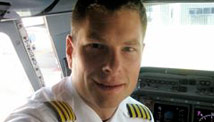Pilot explains air traffic back-ups

- Traffic can pile up even when the sun is shining and the weather overhead looks great
- If a thunderstorm blocks a major route, aircraft basically have to merge into a new lane
- Travel early in the morning to avoid delays; the weather is usually calmer and traffic lighter
Editor's note: Daniel Fahl is a captain for a major U.S. airline. He has been a pilot for 10 years.
(CNN) -- "Airspace congestion" is routinely cited as the cause of air travel delays, particularly in the busy, storm-prone summer months.
It's important for a frequent flier to understand how traffic piles up, even when the sun is shining and the weather overhead looks great.
More often than not, airspace congestion is tied to airports in and around New York. Other major airports in Philadelphia, Pennsylvania; Atlanta, Georgia; and Chicago, Illinois, are also sensitive to congestion. But when the weather is foul, any airport can be affected.
In the greater New York area, three major airports, LaGuardia, JFK and Newark International, all within a 25-mile diameter circle, land and depart hundreds of flights per day. With this many flights, it's crucial to have an organized system of filtering arrivals and departures from each airport at a safe distance.
The system consists of standardized routes that aircraft use to keep out of each other's way, similar to highway on-ramps and exits. In the sky, since there's no pavement to follow, on-ramps and exits are defined by coordinates.
Congestion arises when aircraft from multiple airports are headed in a similar direction. When a flight from Newark departing for Denver, Colorado, a flight from LaGuardia departing for Phoenix, Arizona, and a flight from JFK departing for Los Angeles, California, all head west, it's important to allow enough space between aircraft so they don't arrive at the same coordinate at the same time.
If traffic is light, it's business as usual for air traffic control. But when many flights are headed in the same direction from multiple airports, aircraft may be held on the ground to provide enough spacing. The result for passengers? A tarmac delay.
Departure delays can also occur when many aircraft are trying to depart the same runway. Since airlines generally run large "banks" of flights that arrive at the same time, allowing passengers to connect to flights that will depart at the same time, there can be a long line for take-off.
Most of the time departure bank delays are built into your travel itinerary. It may be a 30-minute flight from New York to Boston, but your ticket may say one hour to account for time on the ground.
Aircraft are also arriving from all directions, and they not only have to be separated from each other, but also from aircraft departing the airport, adding to congestion.
Although many airports have multiple runways, bad weather or runway closures can snarl traffic. If there are 50 flights per hour scheduled to arrive, but the airport can only handle 40 arrivals per hour, someone's going to be delayed.
So which flights get priority for departing on time? That decision often is left to the airlines themselves. The FAA may say 40 flights are allowed per hour, but the airline will decide which flights will be on time. Usually arrivals from overseas will be prioritized, followed by transcontinental flights, then finally the closer-in "regional" flights. This is subject to change, but is the general rule of thumb.
In the summer, departure and arrival routes can quickly become blocked by thunderstorms, usually in the afternoon. And the weather does not necessarily have to be near the airport -- storms between airports can cause backups as well.
If a thunderstorm is blocking a major route, pilots and air traffic control must navigate around the weather. With so many flights arriving and departing in all directions, the storm is similar to a disabled vehicle on a highway causing a traffic jam because everyone's trying to merge into a new lane.
But even without storms, flights can be delayed if "bumper to bumper" aircraft force air traffic control to slow the pace of traffic. Until the traffic jam is eased, your flight will be held on the ground awaiting an open spot on your route.
The best way to avoid delays is to travel early in the morning, as the weather is usually calmer and the traffic is lightest. If you find yourself delayed, chances are that your connecting flight will also be late because of a ripple effect. The more severe the congestion, the more likely flights from other cities will also be delayed. If your connecting flight is on one of those aircraft, clearly you have a fighting chance to make your connection.
But frequently, connection times are not long enough to absorb delays. Pay attention to the layover time between connecting flights as you purchase your ticket. A 30-minute layover to connect to another flight is very challenging at larger airports -- an hour is better.
And watch the weather; if you can avoid forecasted storms by changing your flight, give it a shot. Many airlines have mobile websites that allow you to check a flight's status, so you are that much more in tune with the bigger picture.
